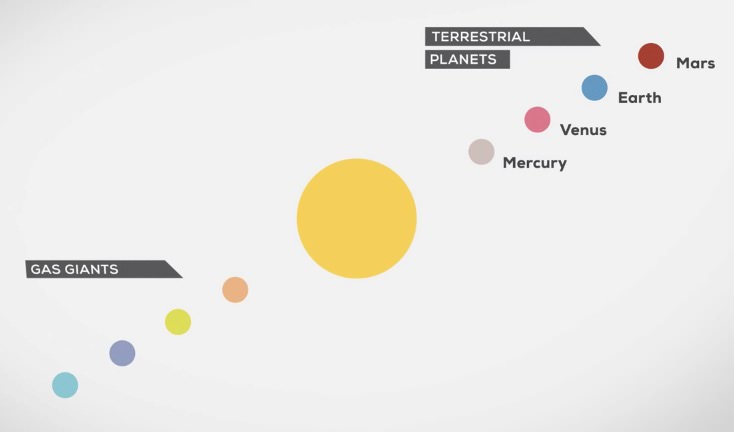The Solar System: it’s our home in space, the neighborhood that we all grew up in and where — unless we figure out a way to get somewhere else — all of our kids and grandkids and great-great-great-great-times-infinity-great-grandkids will grow up too. That is, of course, until the Sun swells up and roasts Earth and all the other inner planets to a dry crunchy crisp before going into a multi-billion year retirement as a white dwarf.
But until then it’s a pretty nice place to call home, if I may say so myself.
Edu-film designer Philipp Dettmer and his team have put together a wonderful little animation explaining the basic structure of the Solar System using bright, colorful graphics and simple shapes to illustrate the key points of our cosmic neighborhood. It won’t teach you everything you’ll ever need to know about the planets and it’s not advisable to use it as a navigation guide, but it is fun to watch and well-constructed, with nice animation by Stephan Rether and narration by Steve Taylor.
Check out the full video below:
“Through information design, concepts can be made easy and accessible when presented in a short, understandable edu-film or perhaps an infographic. Whether explaining the vastness of the universe or the tiniest building blocks of life – all information can be presented in a way that everyone understands. Regardless of prior knowledge.”
– Philipp Dettmer
(And come on, admit it… you learned something new from this!)
Credit: Philipp Dettmer Information Design. HT to Colin Lecher at Salon.


Interesting video, kindof based on the style of Hitchhiker’s Guide. One quibble – “mankind” won’t be around long before the Sun swallows or melts the Earth. The longest a species can last is about 5 million years (definitely not an accurate number). Humans have been around for about 200,000 years, but we won’t be around once the Sun begins it’s new life as a red dwarf – it will be some other species, unless, of course, we destroy ourselves in the meantime (which is much more likely).
Er… I think you had meant to say red giant, not “red dwarf”.
Sorry, you’re right. I had the tv show on my mind.
Good catch. In fact we can say more, hominids become on average ~ 1 million years, with H. erectus 2 million years an outlier.
Not bad, but a few errors:
1) “Uranus is the next largest planet after Saturn” (correct) is followed by “Uranus is the smallest of the gas giants” (not correct). I suspect they meant to say that it’s the least massive.
2) If you include the comets in the “other stuff” category (besides the sun, planets, and moons), it’s incorrect to say “most of these objects are found in the asteroid belt and Kuiper Belt–the number of comets in the Oort cloud almost certainly outnumber everything in the asteroid belt and Kuiper Belt combined.
3) Odd that the planets are depicted (via color difference) as having a day and night side, but moons are shown with light and dark sides which don’t maintain their proper orientation with respect to the sun.
Strictly speaking the terminology has advanced due to the exoplanets. IIRC neptunes such as Uranus are either “ice giants” or “dwarf giants”.
Or something like “Methane Giants” or “Water Giants”. “Ice Giants” is definitely more common though. And it casts a wider net for that class of planet. And I like it better, which is what really matters;).
Nice, though I’m not sure I like all the infograph visualizations as they clutter up a simple exposition.
Besides the inevitable minor nitpicks I have a major one. The video continues the old and likely erroneous model of Jupiter as protecting Earth from impactors. Modern models find that an outer gas giant increases impact rate – a lot:
“Jupiter’s role seems confused. It definitely sends asteroids and comets our way and, in any given year, more than 90 percent of all objects crossing Earth’s orbit are asteroids, so the protection Jupiter provides us from long period comets, or by eventually removing short period comets, is of lesser importance. Hence Jupiter is not the friend that it has been perceived to be. However, things could be far worse: were Jupiter to have a mere 20 percent of its mass, the impact rate would skyrocket. [Because a smaller giant would still push more impactors our way but less efficiently clean out the ones that doesn’t impact.]”
So we are lucky that Jupiter is unusually large for a gas giant.
having the ability to create such things will be dominant over knowledge for a while.